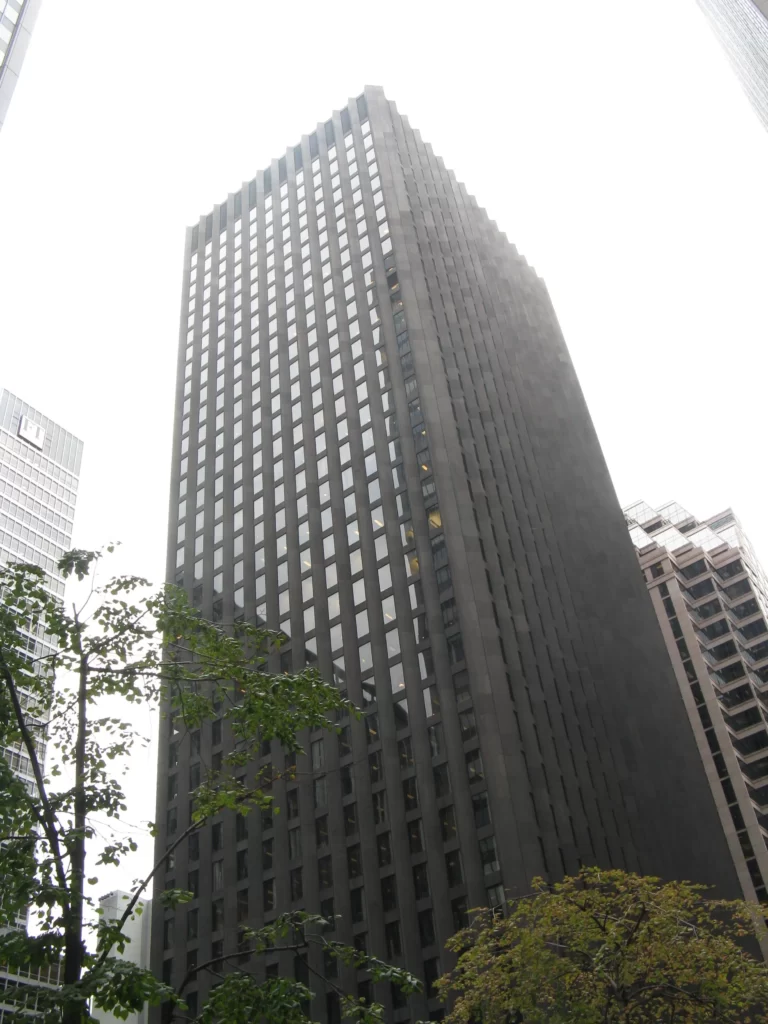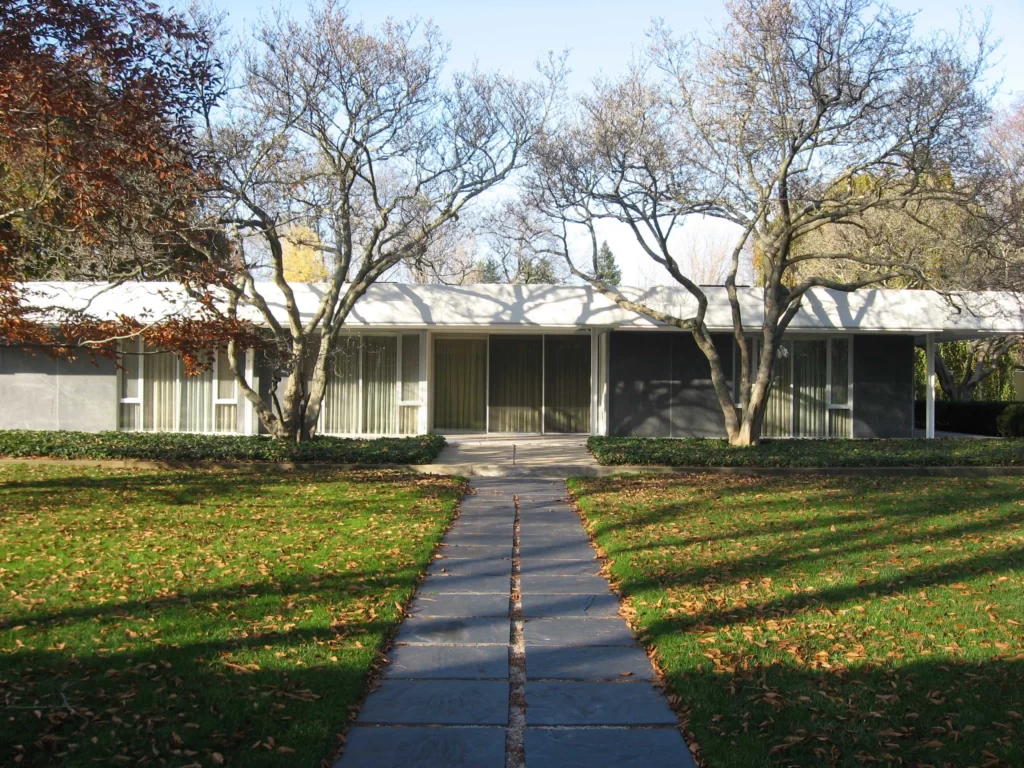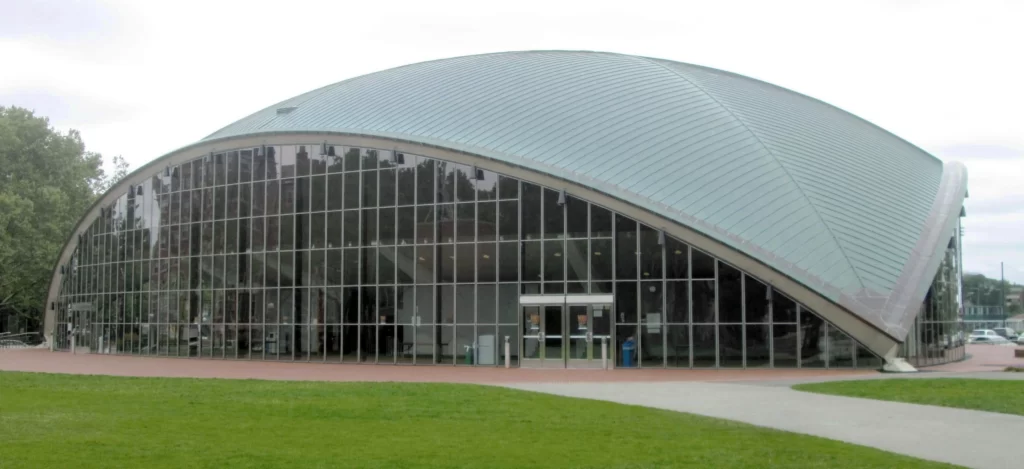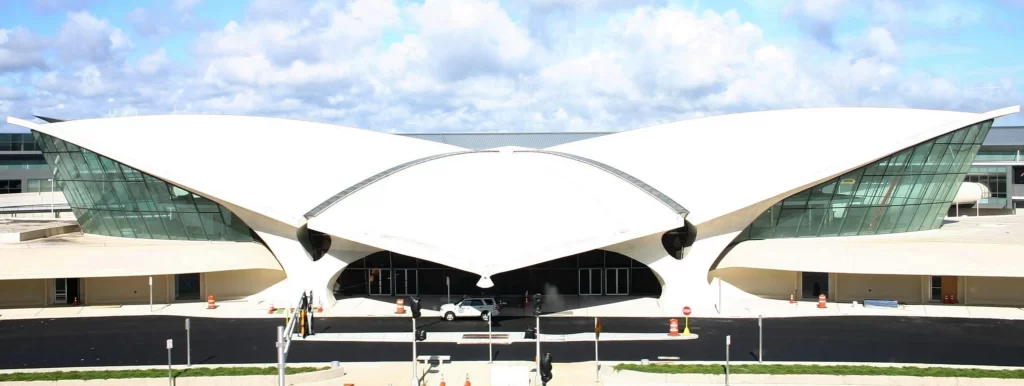If you want to know about the Permeable concrete or Islamic architecture or staircase design, please click the link.
Introduction
Eero Saarinen was a Finnish-American architect and designer who played a significant role in shaping modernist architecture in the mid-20th century.

Known for his innovative use of curves, modern materials, and emphasis on functionality, Saarinen created iconic structures such as the TWA Flight Center and the Gateway Arch. His work continues to inspire architects and designers today.
1) Early Life and Education
Eero Saarinen was born on August 20, 1910, in Kirkkonummi, Finland. His father, Eliel Saarinen, was also an architect and his mother, Loja Saarinen, was a textile designer.
The family moved to the United States in 1923, where Eliel became the head of the Cranbrook Academy of Art in Bloomfield Hills, Michigan.
Education and Early Interest in Architecture and Design
Growing up in an artistic family, Saarinen developed an interest in design and architecture at an early age.
He attended the Cranbrook Academy of Art, where he studied sculpture and furniture design, and later went on to study architecture at the Yale School of Architecture, graduating in 1934.
Key Influences
Saarinen was influenced by a number of key figures in his early career. While at Cranbrook, he studied under the Finnish architect Eliel Saarinen (his father) and Charles Eames, who would later become a close collaborator.
During his time at Yale, he was mentored by the prominent architect Norman Bel Geddes. These influences, along with Saarinen’s own unique vision and talent, would shape his early career and set him on a path to become one of the most innovative architects of his time.
2) Saarinen’s Design Style and Techniques
Eero Saarinen’s design style was characterized by a commitment to functionality, a bold use of curves, and a sculptural approach to form.
His buildings often feature sweeping, organic curves that seem to flow and undulate, lending a sense of movement and dynamism to his structures.
This emphasis on curves was inspired in part by his father’s work as a sculptor, and Saarinen saw architecture as a way to explore the potential of sculptural form in a new medium.
In addition to his use of curves, Saarinen was also known for his innovative use of materials, such as reinforced concrete and structural steel, and his emphasis on the structural integrity of his buildings.
His designs were often engineered to be structurally sound and durable, and he paid close attention to the details of construction to ensure that his buildings would be built to last.
Saarinen’s commitment to functionality was also evident in his designs, which were often tailored to the needs of the specific project or client.
He believed that form should follow function, and that architecture should be responsive to the needs of the people who would use the building.
Saarinen’s Contributions to Modernist Architecture
Eero Saarinen was one of the key figures in the development of modernist architecture in the mid-20th century.
His emphasis on functionality, use of new materials, and sculptural approach to form helped to define the emerging language of modern design.
Saarinen’s designs were characterized by a sense of optimism and a belief in the transformative power of architecture to shape and improve the built environment.
His use of curves and flowing forms represented a departure from the rectilinear shapes of earlier modernist buildings, and helped to create a new vocabulary of form that would come to define modern design in the second half of the 20th century.
Saarinen’s influence was felt not only in his own work, but also in the many architects and designers who were inspired by his example.
His approach to design, which emphasized a commitment to functionality, a bold use of form, and an attention to detail, continues to inform and inspire architects and designers today.
3) Career Beginnings and Major Works
After graduating from Yale, Saarinen briefly worked for his father’s architectural firm before moving to Europe in 1935 to study sculpture and furniture design in Paris and later architecture at the École des Beaux-Arts in Fontainebleau.
In 1936, he returned to the United States and began working for the firm of industrial designer Norman Bel Geddes in New York City.
During his early career, Saarinen designed several notable buildings, including:
i) General Motors Technical Center (1945-1956):

Saarinen’s first major commission was the design of the General Motors Technical Center in Warren, Michigan.
The complex consisted of 23 buildings, including research and development facilities, offices, and testing labs. The project was notable for its innovative use of modern materials and its emphasis on functionality.
ii) Crow Island School (1940-1941):

Saarinen designed this elementary school in Winnetka, Illinois, which was widely praised for its integration of indoor and outdoor spaces, natural lighting, and child-friendly design.
iii) CBS Building (1954-1965):

Saarinen designed the CBS Building in New York City, which became one of his most famous works. The building was notable for its curved glass facade and innovative structural system, which allowed for large, column-free interior spaces.
iv) Miller House (1953):

Saarinen designed this residence in Columbus, Indiana, which was notable for its use of natural materials, such as stone and wood, and its integration with the surrounding landscape.
v) Kresge Auditorium (1953-1955):

Saarinen designed this auditorium at the Massachusetts Institute of Technology, which was noted for its unique roof design and acoustics.
These early works established Saarinen as one of the leading architects of his time, and set the stage for his later, more iconic works.
4) TWA Flight Center
One of Eero Saarinen’s most famous works is the TWA Flight Center at John F. Kennedy International Airport in New York City.

Designed in 1956 and completed in 1962, the building was created for Trans World Airlines (TWA) as a terminal for their international flights.
Design Process and Inspiration
Saarinen’s design for the TWA Flight Center was inspired by the shape of a bird in flight, with sweeping curves and a futuristic, space-age aesthetic.
The building’s unique shape and features were the result of an extensive design process, which involved Saarinen and his team creating numerous models and prototypes to test and refine their ideas.
One of the most notable features of the building is its iconic roof, which is made up of four parabolic concrete shells that appear to soar overhead like wings.
The shells were constructed using a technique called “shotcrete,” in which concrete is sprayed onto a framework of steel rods and mesh. The resulting structure is incredibly strong and durable, while also allowing for a high degree of design flexibility.
Other notable features of the TWA Flight Center include its curved walls, massive windows, and elegant interiors, which were designed to create a sense of spaciousness and airiness.
The building was also equipped with state-of-the-art technology, including an automated baggage system and innovative lighting and ventilation systems.
Challenges and Controversies
While the TWA Flight Center is now widely regarded as a masterpiece of modernist architecture, the project faced a number of challenges and controversies during its construction.
One of the biggest issues was the building’s high cost, which was initially estimated at $8 million but eventually ballooned to over $25 million. The project also faced criticism from some quarters for its futuristic design, which some felt was too radical and unconventional.
Despite these challenges, the TWA Flight Center remains a beloved and iconic building, and a testament to Eero Saarinen’s visionary approach to architecture and design.
5) Collaborations and Partnerships
Eero Saarinen collaborated with a number of notable architects and designers throughout his career, including Charles Eames and Kevin Roche.
These partnerships played an important role in shaping Saarinen’s work, and in turn, Saarinen’s influence helped to shape the work of his collaborators.
Saarinen’s partnership with Charles Eames resulted in a number of iconic furniture designs, including the molded plywood chairs that were produced by the Eames Office in the 1940s and 1950s.
The two men shared a commitment to innovation and a willingness to experiment with new materials and manufacturing techniques, and their collaboration resulted in a number of groundbreaking designs that continue to be popular today.
Saarinen also worked closely with Kevin Roche, who served as his design partner on a number of projects, including the John Deere World Headquarters in Moline, Illinois, and the Bell Labs Holmdel Complex in New Jersey.
Roche’s contributions to these projects were significant, and his experience working with Saarinen helped to shape his own approach to design.
In addition to these collaborations, Saarinen also worked with a number of other architects and designers throughout his career, including Alexander Girard, Florence Knoll, and Harry Bertoia.
These partnerships allowed Saarinen to bring a range of perspectives and expertise to his projects, and helped to ensure that his work remained fresh and innovative.
Overall, Saarinen’s collaborations with other architects and designers played a crucial role in shaping his work, and helped to ensure that his designs remained at the forefront of modernist architecture throughout his career.
6) Criticisms and Controversies
While Eero Saarinen is generally celebrated for his contributions to modernist architecture, his work has not been without its share of criticism and controversy.
Some critics have accused Saarinen of being elitist, pointing to the high cost and exclusivity of some of his projects. Others have expressed concerns about the environmental impact of his buildings, particularly those that require significant amounts of energy to heat and cool.
In terms of accusations of elitism, it is true that many of Saarinen’s projects were expensive and exclusive. For example, the TWA Flight Center at JFK Airport was designed to serve only first-class passengers, and the Kresge Auditorium at MIT was commissioned by the wealthy Kresge Foundation.
However, it is worth noting that Saarinen also worked on a number of public projects, such as the Gateway Arch in St. Louis, that were designed to be accessible to a wide range of people.
With regard to concerns about the environmental impact of his buildings, it is true that some of Saarinen’s projects were energy-intensive. However, it is also worth noting that Saarinen was working at a time when concerns about the environment were not yet a major factor in architectural design.
In recent years, architects and designers have become much more attuned to issues of sustainability, and many have looked to Saarinen’s work as a source of inspiration for creating environmentally responsible buildings.
Overall, while there are valid criticisms of some aspects of Saarinen’s work, it is important to view his work within the context of the time in which he was working. Saarinen was a visionary architect who made significant contributions to modernist architecture, and his work continues to inspire architects and designers today.
7) Influence on Contemporary Architecture
Eero Saarinen’s influence on contemporary architecture and design can be seen in the work of many architects and designers who have sought to expand on and adapt his ideas and techniques.
One of the most notable ways in which Saarinen’s work has been influential is in the use of curves and organic forms in contemporary architecture. Saarinen’s buildings, such as the TWA Flight Center and the Gateway Arch, were characterized by their sweeping curves and sculptural forms, and this approach has been widely emulated by architects working today.
Another key aspect of Saarinen’s work that has been influential is his emphasis on functionality and user experience. Saarinen believed that buildings should be designed to serve the needs of their users, and he placed a strong emphasis on ergonomics and usability in his designs. This approach has been taken up by many contemporary architects, who prioritize the needs of their clients and users in their designs.
In addition to his impact on the broader field of architecture, Saarinen has also inspired many individual architects and designers. For example, architect Zaha Hadid has cited Saarinen as an influence, particularly his use of curved forms and his emphasis on creating fluid, organic spaces.
Designer Marc Newson has also cited Saarinen as an inspiration, particularly in his approach to creating functional, user-friendly objects.
Overall, Saarinen’s impact on contemporary architecture and design is significant and wide-ranging. His ideas and techniques continue to influence architects and designers today, and his legacy is likely to endure for many years to come.
8) Conclusion
Eero Saarinen was a Finnish-American architect who made significant contributions to the field of modernist architecture in the mid-20th century.
Saarinen’s design style was characterized by a commitment to functionality, a bold use of curves, and a sculptural approach to form.
He believed that architecture should be responsive to the needs of the people who would use the building, and he paid close attention to the details of construction to ensure that his buildings would be built to last.
Saarinen’s enduring influence on the field of architecture can be seen in his contributions to the development of modernist architecture, including his innovative use of materials, his emphasis on structural integrity, and his sculptural approach to form.
His approach to design continues to inspire architects and designers today, and his legacy can be seen in the many buildings and structures he designed that continue to stand as testaments to his talent and vision.